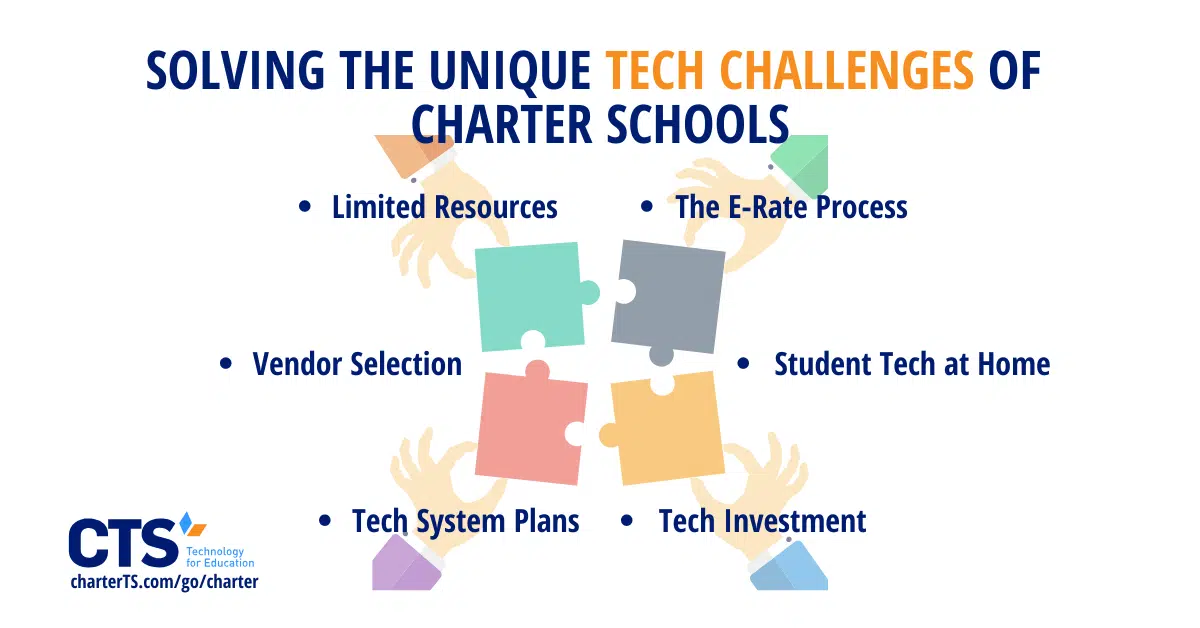Limited resources, whether for technology or not, force charter schools to think creatively.
For school leaders across the country, resource scarcity is a daily reality. From personnel shortages to ever-shifting regulatory requirements, administrators face challenges that go beyond the education of children, an already daunting task.
This reality is particularly true for charter school leaders, who often receive less money than traditional public school districts on a per-pupil basis. Filling the gap requires leaders to think creatively as they solve both educational and operational challenges, eliminating inefficiencies and devising new ways to tackle old challenges. For large networks, this means coordinating tasks across multiple sites, often from a central office staffed with a “network team.” The choices these leaders make about how, and at what scale, to operate their schools yield significant consequences for school communities.
Navigating the annual E-rate process requires time and expertise.
When it comes to technology procurement, effective charter school operators make extensive use of their federal E-rate funds. These dollars, allocated to schools based largely on their enrollment, often supplement the per-pupil dollars that constitute the vast majority of their operating budgets. The process of soliciting bids for and ultimately spending E-rate funds, however, can be cumbersome, forcing many charter schools to hire external E-rate consultants versed in the bidding and selection process.
Once hired, vendors can require extensive management by charter school leaders, draining additional time from other instructional or operational priorities. Selecting an effective, experienced E-rate service provider is therefore critical to a school’s technology programming.
Many students lack access to computers or internet service at home.
Even with an effective technology team in place, charter school leaders often serve student populations with daunting socioeconomic challenges. Many students lack consistent internet access at home, much less laptops or Chromebooks. Meeting the technology needs of their student populations can put a further strain on schools’ limited resources—another reason selecting an effective E-rate service provider is critical to executing an effective educational technology program.
Remote learning brings these challenges into further relief, exposing the technological disparities among students. Using E-rate funds to purchase additional Chromebooks or WiFi hotspots can help mitigate these challenges, ensuring all students have the necessary tools to engage in distance learning.
Multiple sites and lean teams make vendor selection critical to effective technology management at charter schools.
Large charter school networks face technological challenges across multiple sites. Coordinating daily operations, as well as technology purchasing and summer work planning among different sites, requires careful, early planning on the part of network teams.
Many charter schools begin their summer planning many months in advance, sometimes in coordination with the E-rate bidding process. Identifying any existing gaps in their overall technology programs and spending E-rate funds accordingly sets the stage for additional summer projects that can’t be addressed with federal dollars. Engaging both processes simultaneously also gives schools the chance to evaluate their existing technology vendor and gauge whether a change may be necessary.
Private buildings often require significant technology investment before they can serve students.
These challenges are magnified for charter schools looking to expand an existing site or open a new school altogether. While many new schools receive state or federal start-up funds, these dollars typically don’t cover the full cost of launching a new site, particularly one that requires significant technology investments.
If a charter network acquires space in a local church, for example, it may be forced to install additional circuits, wireless access points, and other technology infrastructure to handle the demands of a school. Scaling student and staff device-counts to cover additional enrollment at a new site is similarly costly—another one of the many reasons charter school leaders often look to philanthropic sources for financial support.
Technology systems require clear plans for organization and continuous maintenance.
Once a school’s technology infrastructure is in place, administrators must continuously monitor its systems to maintain functionality for teachers and students.
Managing a regularly updated inventory system, for example, is key to properly accounting for all educational hardware. These systems have become even more important during remote learning, when many schools began loaning devices for students to use while at home. Using their inventory systems as a reference, schools can begin to evaluate their 2020-21 technology needs based on which devices they’re able to account for prior to the fall.
At CTS, we understand the unique technical challenges and solutions of charter schools.
Our team works with more than 60 schools across the country to make the most of every technology dollar. Having received more than $10 million in E-rate awards, we understand the importance of supplementing state and local funding with federal support. Contact us today to learn more about our managed IT services and how we can work with you and your team to make the unique mission of your school a reality.




